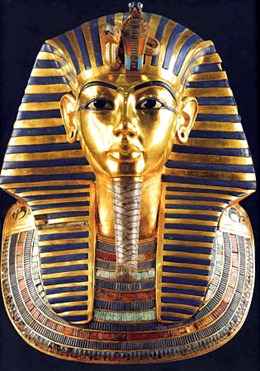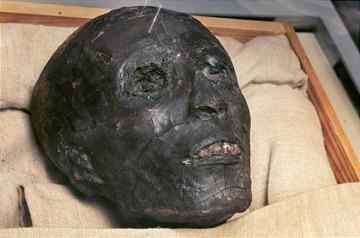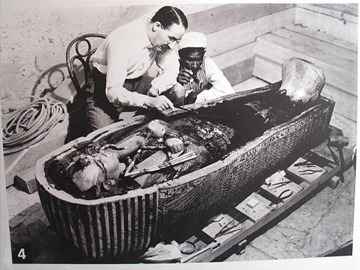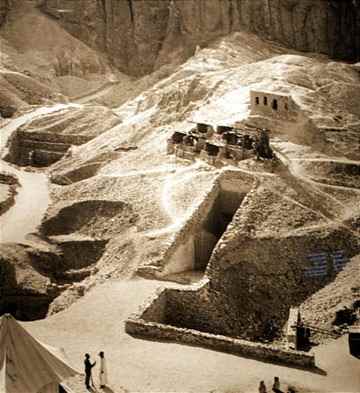Tutankhamun, better known as King Tut — the boy king — was the youngest Pharaoh of Egypt. He was approximately 9 years old when he took over the throne and reigned for nine years. He was considered a minor king due to his short reign as Pharaoh and likely would have been forgotten if not for the discovery of his tomb Nov. 4, 1922, by English archaeologist Howard Carter. The tomb was raided a few times shortly after his burial but it was the most intact tomb ever found. This major discovery by Carter made "King Tut" one of the most famous Pharaohs of all time.
 Most of Tut's life remains a mystery. Tutankhamun was named Tutankhaten at birth. His father, Akhenaten radically changed ancient Egypt from a polytheistic religion (worship of many gods) to a monotheistim (the worship of one god). Because of this he became known as the heretic king. During Tut's reign, Egypt returned to polytheism and the cults of various gods were revived, including the god Amun. Tutankhaten changed his name to Tutankhamun, which means the "living image of Amun."
Most of Tut's life remains a mystery. Tutankhamun was named Tutankhaten at birth. His father, Akhenaten radically changed ancient Egypt from a polytheistic religion (worship of many gods) to a monotheistim (the worship of one god). Because of this he became known as the heretic king. During Tut's reign, Egypt returned to polytheism and the cults of various gods were revived, including the god Amun. Tutankhaten changed his name to Tutankhamun, which means the "living image of Amun."
For years it was believed that Tut had been murdered. A 1968 X-ray indicated he may have been killed by a blow to the head. However, it is now believed that the damage occurred during embalming of the body. In 2005, Tut's mummy was placed into a portable CT scanner which revealed that Tut had died from complications from a badly broken left thigh exacerbated by malaria.
Preserving the dead
Ancient Egyptians believed the soul left the body upon death, rejoined the body after burial and the mummy lived on in the afterlife. Therefore the body had to be well preserved.
 The Egyptians developed a method of drying out the body with natron, a natural salt. Their embalming process took 70 days. It took 40 days to dry the body.
The Egyptians developed a method of drying out the body with natron, a natural salt. Their embalming process took 70 days. It took 40 days to dry the body.
First, all of the vital organs, except the heart, were removed, embalmed separately and placed in containers called canopic jars. The body was then washed with palm wine and spices and covered in natron. Later, resin from trees was poured over the body to help preserve it and the skin was rubbed with a mixture of cedar oil, wax, natron and gum to prevent the skin from cracking.
 Next the body was stuffed with wads of linen, sand or sawdust to give it shape. After all this was done the body was ready to be wrapped in layers of linen and placed in the coffin which was decorated with symbolic pictures and magic spells taken from the Egyptian Book of the Dead. The book was a collection of over 200 spells meant to protect the dead and help them on their journey to the next world.
Next the body was stuffed with wads of linen, sand or sawdust to give it shape. After all this was done the body was ready to be wrapped in layers of linen and placed in the coffin which was decorated with symbolic pictures and magic spells taken from the Egyptian Book of the Dead. The book was a collection of over 200 spells meant to protect the dead and help them on their journey to the next world.
Timeline
LIFE AND DEATH
1343 BC – Tutankhaten, later known as Tutankhamun was born
1334 BC – Tutankhamun was made Pharaoh of Egypt.
1334 BC – Tutankhamun married his half sister Ankhesenpaaten
1331 BC – Tutankhamun changed his name from Tutankhaten to Tutankhamun and Queen Ankhesenpaaten changed her name to Ankhesenamun.
1330 BC – King Tutankhamun, Queen Ankhesenamun and the royal court, moved back to the old capital at Thebes, the center of worship of the Ancient Egyptian god Amun and the power base of the Amun priests.
1325 BC – Tutankhamun dies at the age of 18 or 19.
1324 BC – He was buried in his hastily prepared tomb in the Valley of the Kings 70 days after his death, according to the death rituals of the Ancient Egyptians
1133 BC – The entrance to the tomb of Tutankhamun is buried with rubble when work is being carried out on the tomb of Ramses VI (1141 BC – 1133 BC)

 TOMB DISCOVERY
TOMB DISCOVERY
1891 – Howard Carter goes to Egypt as a junior artist with the Egypt Exploration Fund and is eventually hired by Egypt's Antiquities Service
1907 – Howard Carter was introduced to Lord Carnarvon, who later becomes his patron
1914 – Carter and Carnarvon receive a licence to dig in the Valley of the Kings
1914 – Outbreak of World War I which prevented immediate excavations
1917 – Howard Carter begins his search for the tomb of Tutankhamun.
4 November 1922 – Carter finds the steps leading to Tutankhamun's tomb.
5 November 1922 – Carter cables Lord Carnarvon: "At last have made a wonderful discovery in Valley; a magnificent tomb with seals intact."
26 November 1922 – Carter makes the famous "tiny breach in the top left hand corner" of the tomb doorway accompanied by Lord Carnarvon and his daughter Lady Evelyn Herbert. Carnarvon asks him if he can see anything, Carter replied: "Yes, wonderful things" and goes on to say: "as my eyes grew accustomed to the light, details of the room within emerged slowly from the mist, strange animals, statues, and gold -- everywhere the glint of gold."
16 February 1923 – Howard Carter opens the sealed doorway leading to the burial chamber and the sarcophagus of the Pharaoh Tutankhamun.
1925 – The inner coffin is opened revealing the mummy of Tutankhamun.
1932 – Conservation work on the King Tut treasures is completed and sent to the Cairo Museum.
Fast facts
- Born: 1341 B.C.
- Birthplace: Egypt
- Died: c. 1323 B.C.
- Spouse: Ankhesenpaaten
- Children: 2 daughters who were stillborn
Physical attributes: Slight build, 5 ft. 6 in. at time of death. Tutankhamun had a cleft palate and a club foot. He likely walked with a cane. 130 walking sticks and canes were discovered in Tut's tomb.
Editor's note: "Tutankhamun and the Golden Age of the Pharaohs" exhibit at the Denver Art Museum in Denver, Colo., runs through Jan. 9, 2011. For more information: www.kingtut.org/home.
Author: Heather L. Tuttle | Source: Desert News [November 01, 2010]